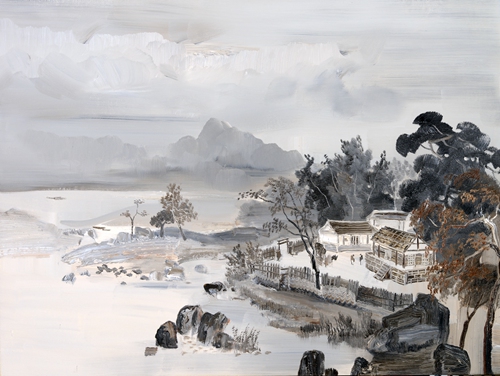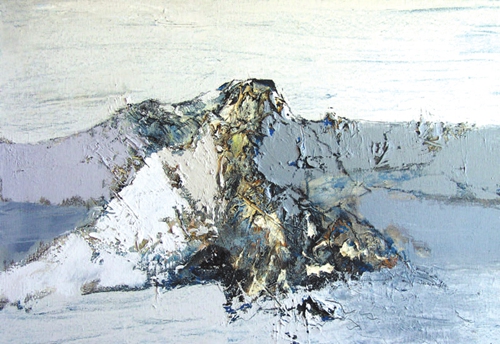
Xu Li
It has only been a little over 100 years since oil paintings were introduced to China, which was dominated by its own traditional paintings. The famous contemporary Chinese painter Xu Li's creative practice follows the artistic path of realism.
Every time he paints, from conception, formation, use of color, shape, and layout, he goes through careful considerations to produce the best work possible. He is proficient at drawing inspiration from ordinary life.
After the oil painting Four-Armed Guanyin was collected by the world's top consortium and the renowned Rockefeller family, his works become a hot spot for oil painting investment and collection.
In 2013, he was awarded the "Outstanding Artistic Achievement Award" by the National Arts Council of the US. In 2015, he was awarded the Honorary Academician by the Russian Academy of Arts and Sciences. In 2017,
Xuli Oil Painting Collection was published in Italy. His 2019 oil painting
Dialogue was collected and displayed in the Leonardo da Vinci Museum in Italy.
Introduction to the artist:Xu Li, born in Fujian Province in 1961, is currently a member of the National Committee of the Chinese People's Political Consultative Conference, secretary of the Party Group of the China Artists Association, director of the National Artistic Creation Committee on Major Themes, and doctoral supervisor.
His works have been selected for the five-year National Art Exhibition for 25 consecutive years.
His works have been collected by China's top museums, but also by overseas celebrities and renowned collectors.
When China meets West The world today is continuing to experience profound changes in the political and economic arenas, a new chapter in which Eastern and Western cultures exchange and merge.
Civilizations are colorful due to exchanges and are enriched due to mutual learning. This phenomenon is particularly prominent in the field of fine arts. It is believed that oil paintings, portraits, perspective and volume modeling can be effectively integrated into the creation of Chinese art.
Most of Xu Li's works confirm this fact. Xu Li combines the mountains and rivers in Da Vinci's paintings with traditional Chinese landscapes in a single painting, and engages in an artistic dialogue between the East and the West.
In his work called
Dui Hua (Dialogue), the mountains and rivers in Da Vinci's 23-year-old sketch become the landscape on the left in Xu Li's creation. The two cleverly combine to form a landscape with Chinese culture and aesthetic interest.
The works were collected and displayed in the Leonardo da Vinci Museum in Italy in 2019. Here, the 500-year gap in time seems to have disappeared, leaving only a fascinating wonderland.

Dui Hua 120 cm x 90 cm, 2018
"Da Vinci is a household name in China as one of the three great masters of the Renaissance. His meticulous research on the human body, as well as the scientific spirit and humanistic sentiments contained in his works, have inspired countless Chinese and Italian artists. I have been engaged in art creation and art organization management for many years, and I know that civilization is colorful due to exchanges, and civilization is enriched by mutual learning. Civilization exchanges and mutual learning are an important driving force for the advancement of human civilization and the peaceful development of the world. My work
Dui Hua combines the mountains and rivers in Leonardo's 23-year-old sketch manuscript with traditional Chinese landscapes. It not only retains the tranquility and simplicity of classical paintings, but also inherits the tranquility and nature of Chinese freehand painting to pay tribute to Da Vinci," Xu Li said.
In
Dui Hua, the outline of the mountain is like a continuous undulating line, winding and reciprocating in the pure tones, like the quietness and simplicity of classical oil painting. As clear and natural as ink painting.

Jia Yuan 120 cm x 90 cm, 2012
For example, the oil painting
Jia Yuan (Homeland) he created in 2013 was inspired by a subtle mountain village. It shows that Western artistic methods can be absorbed into the ancient Chinese visual language, and the language of Western oil paintings can be used to express Eastern culture connotation.
Using the heaviness of Western oil paint to show the Zen rhyme of Eastern ink painting, so that Chinese and Western civilizations that cross time and space and national boundaries can be artistically presented in oil paintings, it strives to create creations that reflect the essence of Chinese culture, reflect the aesthetic pursuit of the Chinese people, and spread the contemporary excellent works of Chinese values. All in line with the trend of world progress.

Xin Hui Huang 450 cm x 260 cm, 2019
In addition, he also created a huge oil painting
Xin Hui Huang (New Glory) for the Beijing Daxing International Airport, showing the vitality of the new era to important guests entering and leaving the port.
As early as the 1990s, Xu Li had inspected the Silk Road many times. While shocked by the glorious historical relics created by the collision of Eastern and Western civilizations, the sacred mountains in the snowy plateau, Snow Mountain, were already deeply in his heart. In this work, all the scenes are derived from his life, combining multiple scenes together.

Yu Shan 100 cm x 70 cm, 2008
Art styleAlthough Xu Li has created countless paintings whose diversity is dazzling and conveys a healthy randomness, he has not shown cynical rebellion and potential hostility towards the post-war "bad boy" art.
He thinks that he and his culture are mature enough to face them calmly. Chinese art prefers subtlety, refinement, and suggestion.
It has long avoided the violent tendencies, endless battle scenes, crosses, pornographic encounters, martyrdom, theft, shipwrecks, rape, kidnappings, and murder. In Western works, all signs of worldview through mutual conflicting personal interests are reflected.
In contrast, Xu Li's work emphasizes the basic unity of traditional Chinese art. His gentle art expresses social harmony and calm, and reflects the calmness of life, which in turn echoes the order of nature and the universe cycle. Regarding the diversity of his work, Xu Li's work is the epitome of the tradition of harmonious coexistence in China.
Alessandro Vezzosi, the director of the Leonardo da Vinci Museum, said that Xu Li's work surprised him.
"Although it has no direct relationship with the Western avant-garde art that in recent years I have been engaged in, he relies on his personal, poetic and aesthetic artistic expressions," Vezzosi remarked.
This kind of artistic expression changes with his different creative periods, but he has always maintained a true expression of his emotions and thoughts.
Xu Li's oil painting language abandons the common block-surface shaping methods, and uses almost flat-painting techniques to draw dots and dyes on the canvas.
It incorporates the tone and meaning of traditional Chinese freehand painting, and also takes care of the special heaviness of the oil painting language. In his work, he attempts to integrate the concentration and texture of colors to express the layering and heaviness of abstract nature.

Nei Meng Feng Guang 120 cm x 90 cm, 2012
From the landscapes he describes, one can see the changing process of the selected theme from the beginning of writing to its formation, which reflects his in-depth observation of nature and forms his own set of dynamic expression system.
The various components of the landscape in his paintings are represented by lines and large color blocks. They are not just to paint a specific image, but to show the dynamic evolution of the image.
Sometimes they are formed by gradually deepening pigment clots, sometimes intertwined by melody-like music, intermittent lines, arousing viewers' positive thinking.
Hastily, but deep and stable. There is endless tension in the tranquility, and the active spirit of life is gestated in the tranquility.
This is the artistic spirit of the East and the wisdom brought to the world by Chinese oil painting artists.
Xu Li is a practitioner, inheritor, and disseminator of the nationalization of oil painting in the new era.
He has opened up a new realm of contemporary Chinese oil painting and at the same time deepened China's cultural proposition.
"In the past, we talked less about the Chinese spirit because the country was weak at that time, and more of it was influenced and impacted by Western culture," Xu Li said.
"Over the past 30 years of reform and opening-up, with the progress and development of the country, Chinese people are also understanding, re-emerging, and holding high the cultural banner of the Chinese spirit."









